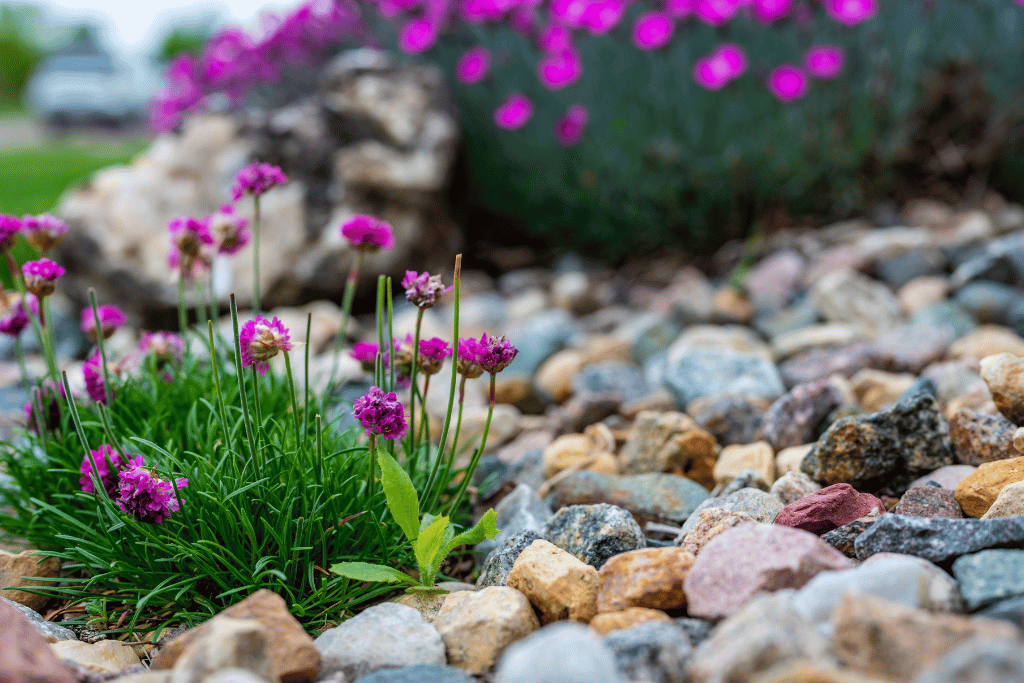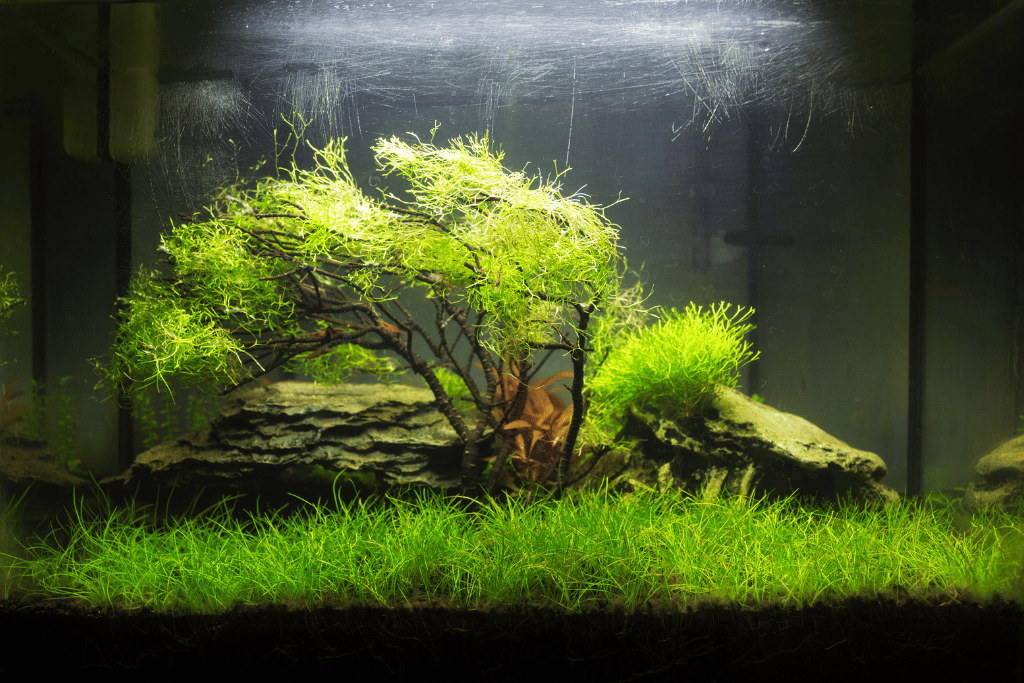
Looking to add some greenery to your aquarium without the hassle of CO2 injection? We’ve got you covered. Carpet plants are low-growing, horizontally spreading plants that add aesthetic appeal and help maintain a healthy aquatic environment.
However, choosing the right plant for your aquarium’s specific conditions can be a challenge, especially when it comes to CO2 injection.
In this article, we’ll be focusing on the best carpet plants for aquariums that don’t require CO2 injection.
Say goodbye to the CO2 struggle and hello to a lush, green carpet effect in your aquarium!
Dwarf Sagittaria
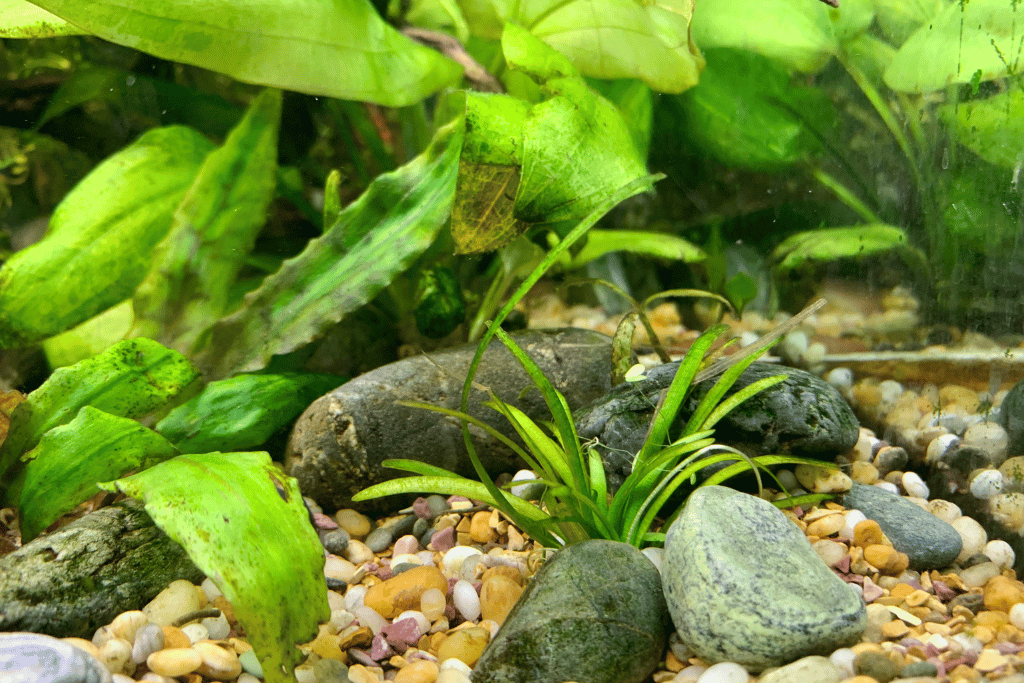
This is one of my favorites; it is a real trooper and known to grow in a wide range of water conditions making it one of the best carpet plants for beginners or aquarium enthusiasts.
Growth Rate
In terms of growth rate, the Dwarf Sagittaria is relatively slow, but it’s with the wait. It can reach up to 6 inches in height and spreads rapidly, creating a lush green carpet effect in your aquarium.
Lighting / Water Conditions
The Dwarf Sagittaria is not demanding when it comes to light requirements and can thrive in moderate to low light, so you don’t need to go all out on fancy lighting equipment for this one. A full spectrum LED light with a color temperature of around 6500K is a good choice for most aquarium plants, including Dwarf Sagittaria.
Make sure you place the light at a proper distance from the plant to avoid burning the leaves or promoting algae growth.
Dwarf Sagittaria prefers slightly alkaline water with a pH between 6.5 and 7.5. It can tolerate a range of temperatures but ideally should be kept between 68F and 82F.
Planting/ Pruning
When planting Dwarf Sagittaria, using a nutrient-rich substrate is important to encourage healthy root growth. A fine gravel or sand substrate mixed with some aquatic plant soil can work well. The substrate should be at least 2 inches deep to allow for a substantial root system.
As for pruning, you can trim the leaves and runners to keep them in shape and prevent it from overgrowing. Adding liquid fertilizer once a week will keep it looking great. The frequency of fertilizing may differ depending on the brand, so always check the instructions on the label.
Another way to encourage healthy growth is to consider adding snails to your aquarium- they’ll keep the plant free of algae and debris.
The Dwarf Sagittaria is an excellent choice if you want to keep things low-key and don’t want to fuss with complicated lighting or CO2 injection.
Java Moss
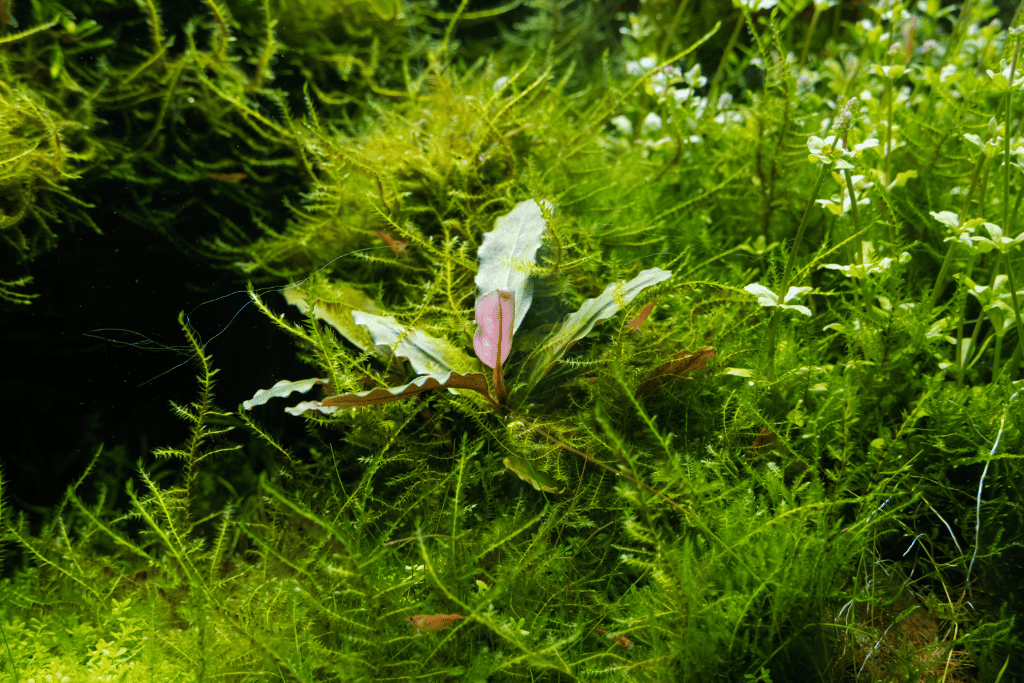
Another popular carpet plant that doesn’t require CO2 injection is Java Moss. This versatile plant is known for its unique appearance, growing in a dense, tangled mass of tiny green leaves. It’s perfect for creating a natural look in your aquarium and also acts as a great hiding spot for fish and shrimp.
Growth Rate
Java moss is a relatively slow grower but can quickly cover surfaces if left unchecked. It doesn’t grow very tall, typically growing to around 2 to 4 inches (5 to 10cm) when matured. However, its growth rate can vary depending on the conditions in your aquarium, such as lighting, water quality, and nutrient availability.
Lighting/ Water Conditions
This hardy little moss grower thrives in low to moderate light conditions but can also tolerate brighter lighting. Too much lighting can cause algae to grow on the moss, harming its growth and appearance. A full spectrum LED light with a color temperature between 5000K and 7000K is best to maintain the Java moss. Additionally, be sure to provide a photoperiod of 8 to 10 hours per day.
The ideal water temperature for Java moss is between 70F and 75F, but it can tolerate a range between 59-85F. The optimum pH levels for Java moss are slightly acidic and should be between 6.0 and 7.5.
Planting/Pruning
When planting Java moss, you must attach it to a surface like rocks, driftwood, or even aquarium decorations. It doesn’t require a substrate but can benefit from a nutrient-rich substrate like Aquasoil or Fluorite. You can also add liquid fertilizer to ensure it’s getting all the nutrients it needs to thrive.
Java moss is a low-maintenance plant and doesn’t require trimming, but you can prune it back if it becomes too overgrown. It can also benefit from cleaning to remove any debris or algae that may accumulate on the surface.
Java moss is a great choice for anyone looking for a low-maintenance carpet plant for their aquarium. It’s easy to grow, versatile, and provides numerous benefits for fish and shrimp.
Cryptocoryne Parva

Next up on our list of best carpet plants without CO2 ingestion is Cryptocoryne parva. This plant is a great option for those who want a carpet of lush greenery without spending much time and effort maintaining it.
Growth Rate
The Cryptocoryne parva is a slow but steady grower. It can take a while to establish, but when it does, it can form a dense carpet that covers the entire substrate. It grows to a height of about 2-3 inches, making it great for foreground planting.
Lighting/ Water Conditions
Cryptocoryne parva is not too demanding when it comes to light and can thrive in low to moderate lighting conditions, but it may slow down in lower light.
It can do well under as little as 1 watt per gallon of fluorescent lighting or with an LED light of around 20-30 PAR (Photosynthetically Active Radiation). However, it is important to note that too much light can lead to algae growth, so it is best to ensure you find a balance that works for your aquarium.
In terms of water parameters, Cryptocoryne parva grows best in a temperature range of 68-82 F (20-28C). It can tolerate slightly cooler or warmer but may not grow as well. The ideal pH range for the Cryptocoryne parva is between 6.0-7.5. It also likes soft to moderately hard water with a dGH of 2-12.
Planting/Pruning
When planting Cryptocoryne parva, it’s best to use a substrate that is rich in nutrients. You can use aquarium soil or nutrient-rich soil specifically designed for aquatic plants. Make sure you prepare the substrate well before planting, ensuring it is clean and free of debris. If you are using aquarium soil, wet it thoroughly before adding it to your tank.
The Cryptocoryne parva is best planted in groups of three or more to create a fuller appearance, and when you plant them, make sure the roots are fully covered but avoid burying the crown of the plant.
It can also benefit from the occasional fertilizer to ensure it’s getting all the necessary nutrients. As for trimming and pruning, you can remove any yellow or dead leaves to keep them looking healthy.
For an added extra, try adding shrimp or snails to your aquarium. They keep the plant clean and free from algae and debris. It’s also a good idea to perform regular water changes to keep the water clean and healthy.
Staurogyne Repens
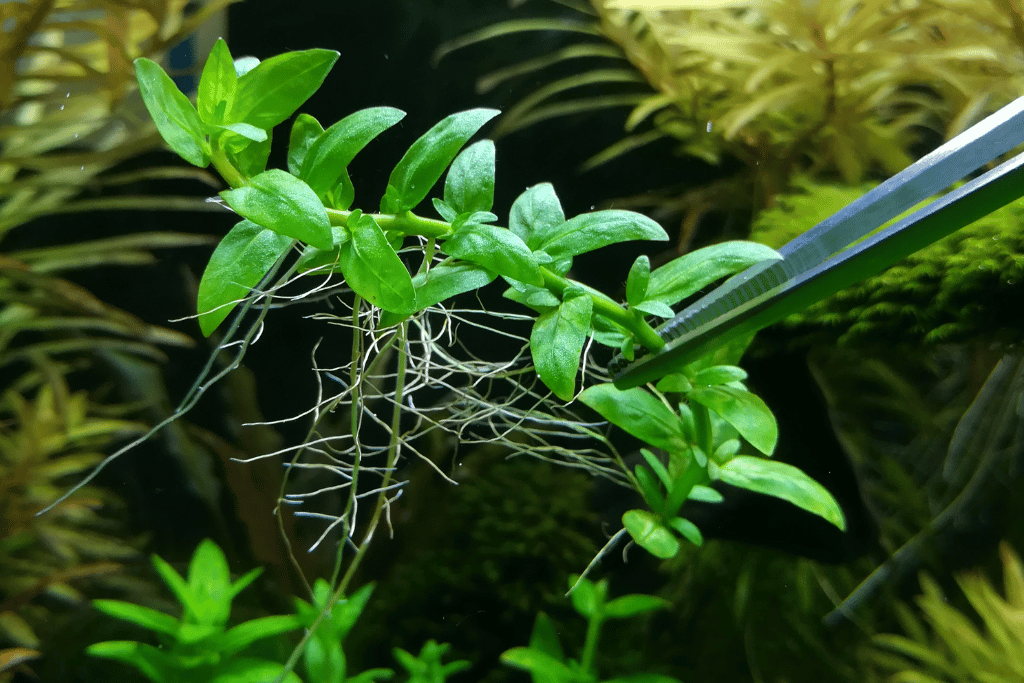
The Staurogyne repens is a beautiful and popular carpet plant that is perfect for adding some natural greenery to your aquarium without the use of CO2 injections. Let’s dive into the plant details.
Growth Rate
This caustic carpet plant is known for its fast growth rate, making it perfect for those with little patience. It can grow up to 3 inches in height, but with proper maintenance, you can keep it shorter and denser.
Lighting/ Water Conditions
The Staurogyne repens is considered a moderate to high light plant. So, if you’re looking for an aquarium plant that needs a bit of extra attention in the light department, this might be the one for you. For optimal growth and color, providing at least 2 watts of light per gallon of water is recommended. It’s also important to note that Staurogyne repens can adapt to lower light levels, but it may not grow as fast or become as vibrant in color as it would under optimal lighting conditions.
If you’re not sure whether your lighting is suitable for Staurogyne repens you can use a PAR meter to measure the light intensity in your tank. Aim for a PAR reading of 30-50 at the substrate level for moderate lighting and 50-80 for high lighting. This will help ensure your plants get enough light to thrive without causing algae growth.
When it comes to the water requirements, this plant does best in slightly acidic to neutral water with a pH range between 6.0 and 7.5. It also prefers soft to moderately hard water and a temperature range between 72F and 82F.
Planting/Pruning
When planting the Staurogyne repens, using a nutrient-rich substrate is important. Staurogyne repens is one of the best aquarium plants for gravel. However, make sure you choose a fine-grained gravel that won’t damage the roots of the plant. You can, of course, use aquarium soil or sand, but sand doesn’t hold nutrients like the others, so you may need to use root tabs or liquid fertilizers.
If you do give your Staurogyne repens a boost of fertilizer, aim to do it once a week and add it to the water column. Always follow the instructions on the label and only use the fertilizer specifically formulated for aquarium plants. You can prune the carpet plant regularly to keep it in shape and prevent it from overgrowing. They grow pretty quickly, so it’s best to keep an eye on them.
Micranthemum tweediei
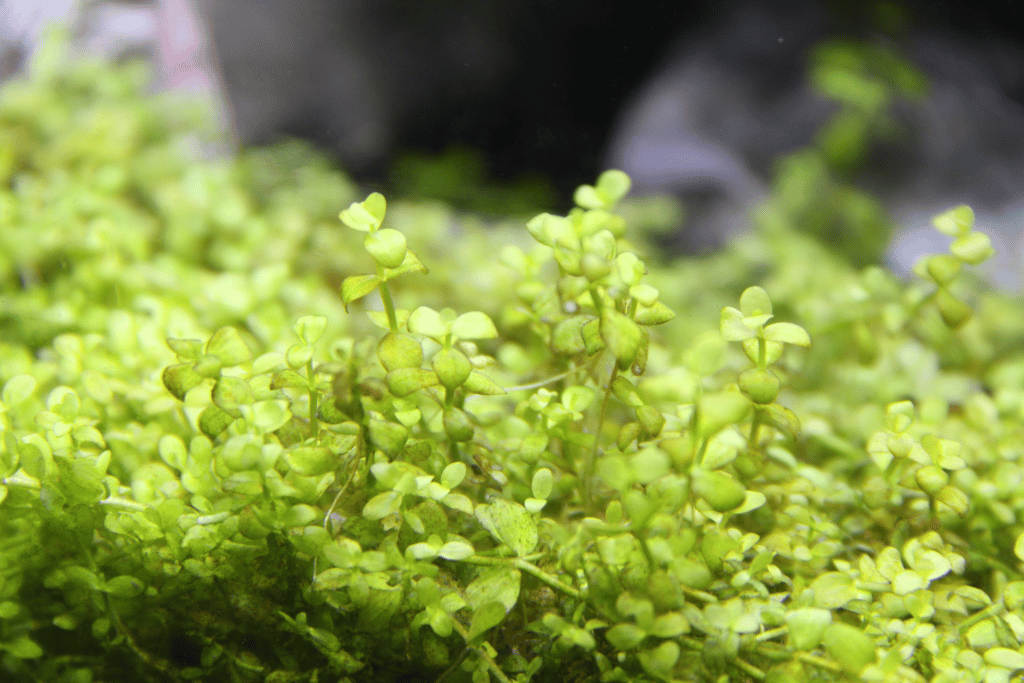
Another excellent carpet plant that’s worth considering is Micranthemum tweediei, also known as Monte Carlo. This plant has a beautiful green color and will create a stunning carpet effect in your aquarium.
Growth Rate
Monte Carlo is relatively fast-growing compared to other carpet plants. It can grow up to 2 inches in height and spread quickly to cover a large area. It’s an excellent option if you want to achieve a dense carpet in a shorter period.
Lighting/ Water Conditions
Micranthemum tweediei needs moderate to high light to grow and thrive. If it doesn’t receive enough light, it can become leggy and start to lose its lush green color. Try to provide at least 2 watts of light per gallon of water or a PAR reading of 50-80 at the substrate level. As with most aquatic plants, the Micranthemum tweediei prefers slightly acidic to neutral water with a pH between 6.0 and 7.5. It also has a temperature range between 68F and 82F, making it one of the best carpet plants for low-tech aquariums.
Planting/Pruning
When planting the Micranthemum tweediei, try to use a rich substrate like aquarium soil to allow its roots to establish quickly. You can also add liquid fertilizers and root tabs to ensure it’s getting all the nutrients it needs to thrive. Don’t overdo it on the fertilizer, though; it can affect the water quality and encourage the buildup of algae. Always follow the instructions on the fertilizer package to ensure proper dosage.
Trimming and pruning are also crucial to maintaining the plant’s shape and encouraging healthy growth. Be sure to trim it regularly to prevent it from overgrowing and shading out other plants in your aquarium.
Effortless Aquascaping: Unveiling the Top 5 Best Carpet Plants for Aquariums without CO2
Creating a stunning landscape in your aquarium is an exciting and fulfilling hobby, but it can also be a daunting task. However, there are many carpet plants that are both low maintenance and do not require C02 injection to thrive. These plants not only add a touch of natural beauty to your aquarium but also provide essential benefits to the water quality by absorbing excess nutrients.
Whether you’re a seasoned expert or just starting out with aquascaping, these plants are a great choice for anyone that wants to create a stunning underwater landscape.
Ready to Find Out More About Aquatic Plants?
We love to share all our garden knowledge with you, head over to our planting 101 pages to get more insight on your little green friends! Our website is well-equipped with everything you need to keep you inspired on your garden-growing journey.


